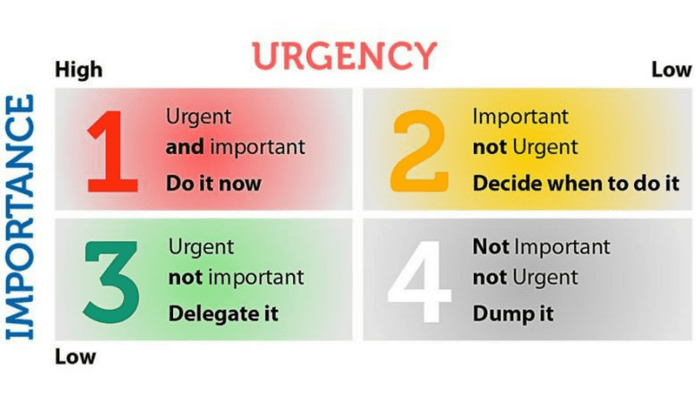 There are things we need to do, things we should do, and things we like to do. We all understand that. Often, we go through our lives just doing what seems best at the moment. But flying by the seat of your pants isn’t living a life by your own design.
There are things we need to do, things we should do, and things we like to do. We all understand that. Often, we go through our lives just doing what seems best at the moment. But flying by the seat of your pants isn’t living a life by your own design.
In 1954, President Dwight D. Eisenhower gave an address where he referred to a former college president who once said, “I have two kinds of problems, the urgent and the important. The urgent are not important and the important are never urgent.”
This statement quickly became associated with Eisenhower’s own ability to get a lot of important things done around the Oval Office (like building a web of interstate highways and creating NASA, for instance). And from this golden nugget, the Eisenhower Matrix was born.
The Eisenhower Matrix is to time management what a microscope is to scientists – it gives us a lens that allows us to examine important things more closely. By using it, you can assign priority to everything in your professional and personal life based on what you perceive its level of both urgency and importance to be.
Most people with reasonable time management skills spend their time working on activities that belong in the first and second boxes of the matrix. These two quadrants require our focus and attention, and need to be protected through a time block.
Keeping Focused on Boxes 1 and 2
What this matrix really does, is it requires us to separate out “what and “when”, so we can prioritize our time in an optimal way.
All of our most pressing and demanding tasks belong in Box 1 — they need to happen and they need to happen now. In other words, they’re most likely our ONE Thing. Tasks that may not demand as much urgency, but still rank as something highly important, find a home in Box 2. These are things that belong on your calendar and may eventually fall into your ONE Thing, but that don’t necessarily need your attention just yet.
Everything in these two boxes have to be time blocked. Our focus requires it. Whether they need to get done now or tomorrow, they need a space and time to be worked through and completed. Consider a work item like lead generating for business or a personal task like attending your child’s school performance as a Box 1 task.
If you’re wondering how and when to allocate time for a Box 2 task, start with putting together a GPS. Whether you’re looking to at the next long-term project in your pipeline or deciding what exercise classes you will take next week, having a plan in place matters. When we plan for something, we make our first commitment to taking action. In a lot of ways, it’s your first domino.
Delegating and Finding the Trash Can
Box 3 of the matrix is for those activities that are urgent, yet not important. Unread emails sitting in our inbox, meetings that need to be scheduled, responding to a customer complaint — you get the idea.
Ideally, the tasks in this category can be delegated. That doesn’t mean they’re not important, it just means it doesn’t directly require your attention. Think of these things as action items that fall in line with your ONE Thing, but can be leveraged out and supported by others.
And then finally, there are the items and tasks that get put into Box 4. These are the non-important and non-urgent things, and frankly, you shouldn’t be wasting your time with any of them. Fiddling around on the web? Quadrant 4. Playing Candy Crush? Quadrant 4. Organizing your files? Chances are, that can be assigned to the fourth section of the matrix as well.
All too often, the activities in the fourth box are what keep you from accomplishing your ONE Thing. They’re distractions and shiny objects. Once you make a point to rid these activities from your life and exchange them for more time and focus on the first two quadrants, your productivity will soar.
What changes did you make from applying the Eisenhower Matrix to your professional and personal life?
